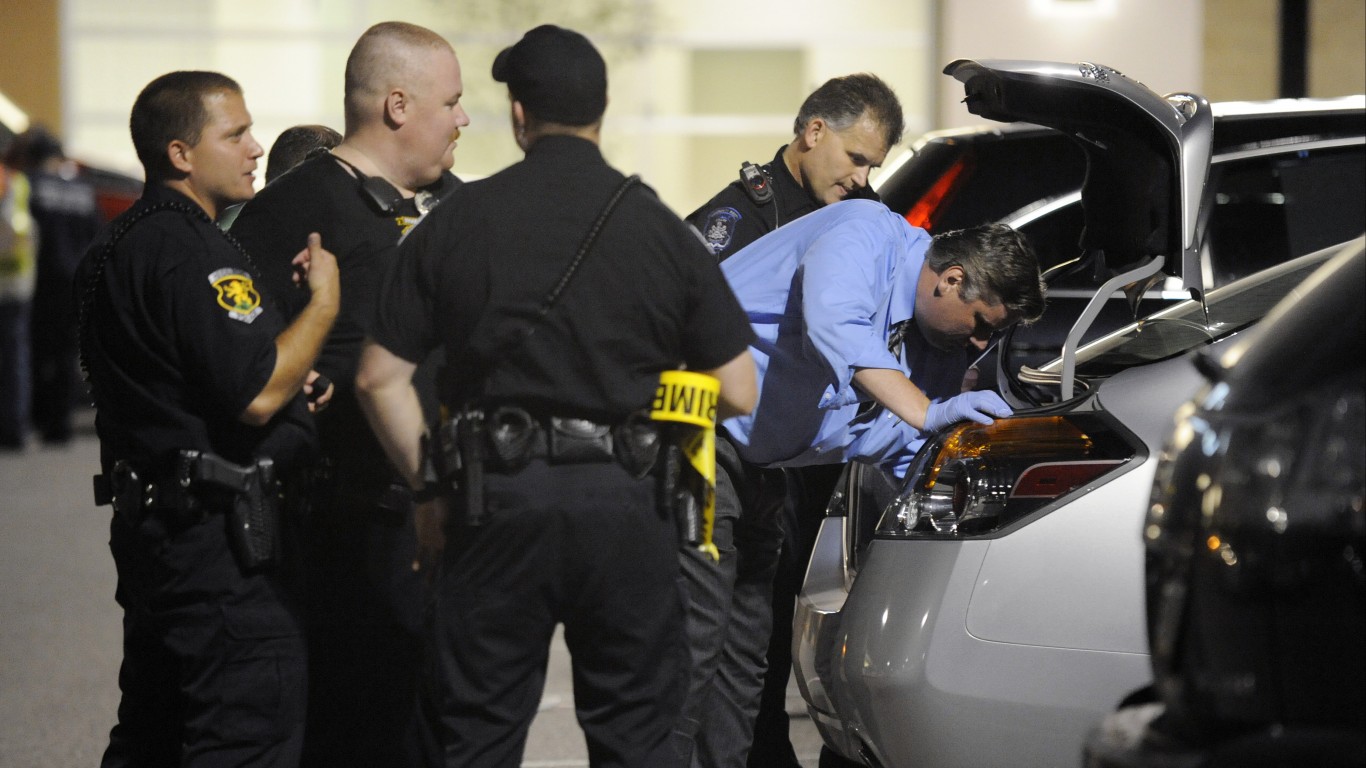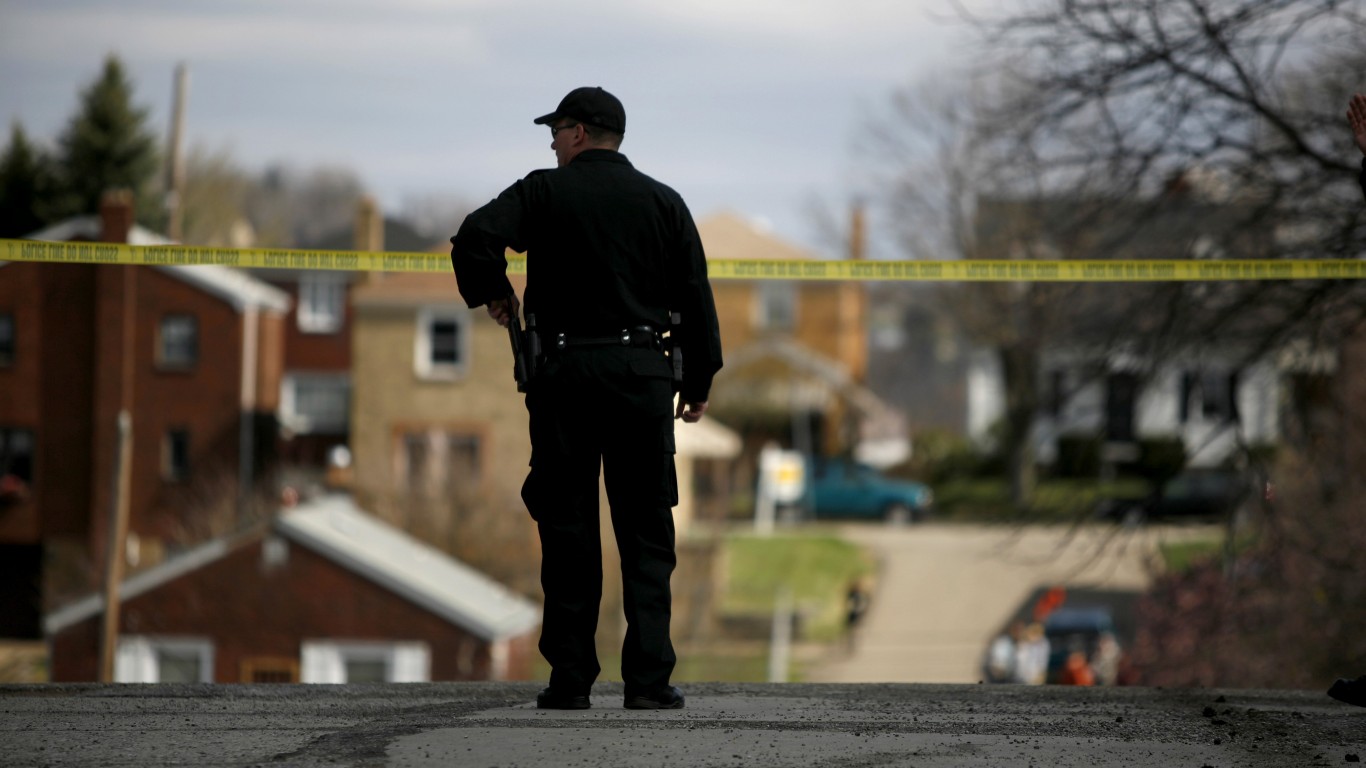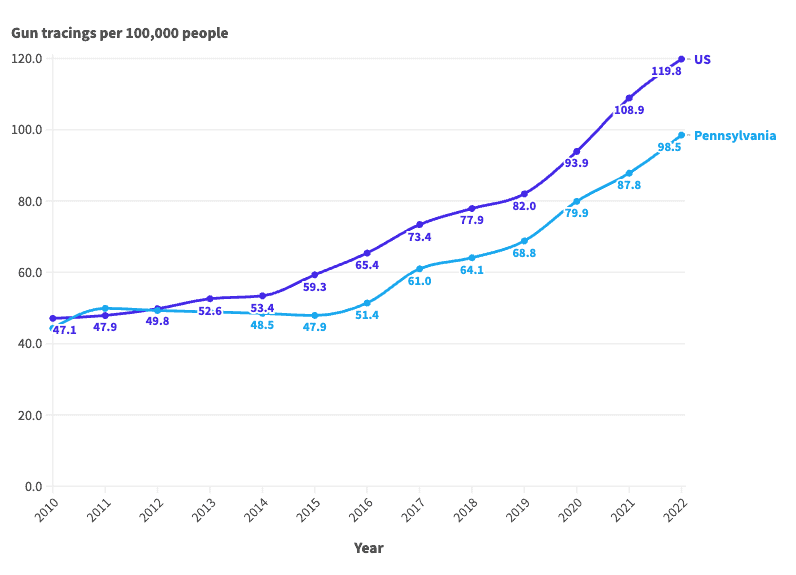
Firearm sales have hit historic highs in the U.S. in recent years, and the ongoing proliferation of firearms may be fueling a rise in gun crime.
When firearms are recovered at a crime scene or taken from a suspect, they are often reported to the Bureau of Alcohol, Tobacco, Firearms, and Explosives for tracing. In these cases, the ATF assists in criminal investigations by using serial numbers and other markings to determine when and where a firearm was originally purchased — and over the last 12 years, firearm-related offenses have been taking up a growing share of federal resources.
Between 2010 and 2022, the number of guns traced by the ATF surged by 174%, from 145,600 to 399,400, climbing by anywhere from 3% to 18% in a single year. Most homicides in the U.S. are committed with a firearm, and over the same period, the national homicide rate climbed by over 50%.
While not all guns traced by the ATF were used in a crime — and not all firearms used for illicit purposes are traced — federal tracing data offers valuable insight into trends and geographic patterns related to gun violence in the United States.
Mirroring the national trend, gun tracings are up sharply in Pennsylvania. The ATF traced 12,772 seized firearms in the state in 2022, compared to 5,631 in 2010. Still, adjusting for population, gun crime appears less common in Pennsylvania than it is across the U.S. as a whole. In 12 of the last 13 years, the number of firearm tracings for every 100,000 people in the state was below the comparable national rate.
As of 2022, the most recent year of available data, the ATF traced 98 seized firearms for every 100,000 people in the state, the 24th lowest gun-tracing rate among states.
2010: 5,631 firearms traced by the ATF

- Firearms traced by the ATF in Pennsylvania, 2010: 44.3 per 100,000 people (20th highest)
- Firearms traced by the ATF nationwide, 2010: 47.1 per 100,000 people
- Pennsylvania homicide rate, 2010: 5.1 per 100,000 people (17th highest)
- U.S. homicide rate, 2010: 4.8 per 100,000 people
2011: 6,364 firearms traced by the ATF

- Firearms traced by the ATF in Pennsylvania, 2011: 49.9 per 100,000 people (16th highest)
- Firearms traced by the ATF nationwide, 2011: 47.9 per 100,000 people
- Pennsylvania homicide rate, 2011: 5.0 per 100,000 people (19th highest)
- U.S. homicide rate, 2011: 4.7 per 100,000 people
2012: 6,293 firearms traced by the ATF

- Firearms traced by the ATF in Pennsylvania, 2012: 49.3 per 100,000 people (22nd highest)
- Firearms traced by the ATF nationwide, 2012: 49.8 per 100,000 people
- Pennsylvania homicide rate, 2012: 5.5 per 100,000 people (15th highest)
- U.S. homicide rate, 2012: 4.7 per 100,000 people
2013: 6,250 firearms traced by the ATF

- Firearms traced by the ATF in Pennsylvania, 2013: 48.9 per 100,000 people (25th highest)
- Firearms traced by the ATF nationwide, 2013: 52.6 per 100,000 people
- Pennsylvania homicide rate, 2013: 4.8 per 100,000 people (18th highest)
- U.S. homicide rate, 2013: 4.5 per 100,000 people
2014: 6,202 firearms traced by the ATF

- Firearms traced by the ATF in Pennsylvania, 2014: 48.5 per 100,000 people (25th lowest)
- Firearms traced by the ATF nationwide, 2014: 53.4 per 100,000 people
- Pennsylvania homicide rate, 2014: 4.8 per 100,000 people (19th highest)
- U.S. homicide rate, 2014: 4.4 per 100,000 people
2015: 6,129 firearms traced by the ATF

- Firearms traced by the ATF in Pennsylvania, 2015: 47.9 per 100,000 people (21st lowest)
- Firearms traced by the ATF nationwide, 2015: 59.3 per 100,000 people
- Pennsylvania homicide rate, 2015: 5.2 per 100,000 people (18th highest)
- U.S. homicide rate, 2015: 4.9 per 100,000 people
2016: 6,575 firearms traced by the ATF

- Firearms traced by the ATF in Pennsylvania, 2016: 51.4 per 100,000 people (19th lowest)
- Firearms traced by the ATF nationwide, 2016: 65.4 per 100,000 people
- Pennsylvania homicide rate, 2016: 5.3 per 100,000 people (25th highest)
- U.S. homicide rate, 2016: 5.4 per 100,000 people
2017: 7,816 firearms traced by the ATF

- Firearms traced by the ATF in Pennsylvania, 2017: 61.0 per 100,000 people (22nd lowest)
- Firearms traced by the ATF nationwide, 2017: 73.4 per 100,000 people
- Pennsylvania homicide rate, 2017: 5.8 per 100,000 people (20th highest)
- U.S. homicide rate, 2017: 5.3 per 100,000 people
2018: 8,211 firearms traced by the ATF

- Firearms traced by the ATF in Pennsylvania, 2018: 64.1 per 100,000 people (20th lowest)
- Firearms traced by the ATF nationwide, 2018: 77.9 per 100,000 people
- Pennsylvania homicide rate, 2018: 6.1 per 100,000 people (15th highest)
- U.S. homicide rate, 2018: 5.0 per 100,000 people
2019: 8,810 firearms traced by the ATF

- Firearms traced by the ATF in Pennsylvania, 2019: 68.8 per 100,000 people (21st lowest)
- Firearms traced by the ATF nationwide, 2019: 82.0 per 100,000 people
- Pennsylvania homicide rate, 2019: 5.3 per 100,000 people (19th highest)
- U.S. homicide rate, 2019: 5.1 per 100,000 people
2020: 10,228 firearms traced by the ATF

- Firearms traced by the ATF in Pennsylvania, 2020: 79.9 per 100,000 people (19th lowest)
- Firearms traced by the ATF nationwide, 2020: 93.9 per 100,000 people
- Pennsylvania homicide rate, 2020: 7.9 per 100,000 people (12th highest)
- U.S. homicide rate, 2020: 6.5 per 100,000 people
2021: 11,386 firearms traced by the ATF

- Firearms traced by the ATF in Pennsylvania, 2021: 87.8 per 100,000 people (22nd lowest)
- Firearms traced by the ATF nationwide, 2021: 108.9 per 100,000 people
- Pennsylvania homicide rate, 2021: 25.2 per 100,000 people
- U.S. homicide rate, 2021: 7.7 per 100,000 people
2022: 12,772 firearms traced by the ATF

- Firearms traced by the ATF in Pennsylvania, 2022: 98.5 per 100,000 people (24th lowest)
- Firearms traced by the ATF nationwide, 2022: 119.8 per 100,000 people
- Pennsylvania homicide rate, 2022: 14.7 per 100,000 people (the highest)
- U.S. homicide rate, 2022: 7.3 per 100,000 people

| Year | Firearm tracings per 100,000 people in Pennsylvania | Firearm tracings per 100,000 people in the US | Total firearms traced by the ATF in Pennsylvania | Total firearms traced by the ATF in the US |
|---|---|---|---|---|
| 2022 | 98.5 | 119.8 | 12,772 | 399,397 |
| 2021 | 87.8 | 108.9 | 11,386 | 361,587 |
| 2020 | 79.9 | 93.9 | 10,228 | 306,686 |
| 2019 | 68.8 | 82.0 | 8,810 | 269,250 |
| 2018 | 64.1 | 77.9 | 8,211 | 254,700 |
| 2017 | 61.0 | 73.4 | 7,816 | 239,175 |
| 2016 | 51.4 | 65.4 | 6,575 | 211,384 |
| 2015 | 47.9 | 59.3 | 6,129 | 190,538 |
| 2014 | 48.5 | 53.4 | 6,202 | 170,344 |
| 2013 | 48.9 | 52.6 | 6,250 | 166,426 |
| 2012 | 49.3 | 49.8 | 6,293 | 156,346 |
| 2011 | 49.9 | 47.9 | 6,364 | 149,276 |
| 2010 | 44.3 | 47.1 | 5,631 | 145,604 |
It’s Your Money, Your Future—Own It (sponsor)
Retirement can be daunting, but it doesn’t need to be.
Imagine having an expert in your corner to help you with your financial goals. Someone to help you determine if you’re ahead, behind, or right on track. With SmartAsset, that’s not just a dream—it’s reality. This free tool connects you with pre-screened financial advisors who work in your best interests. It’s quick, it’s easy, so take the leap today and start planning smarter!
Don’t waste another minute; get started right here and help your retirement dreams become a retirement reality.
Thank you for reading! Have some feedback for us?
Contact the 24/7 Wall St. editorial team.



